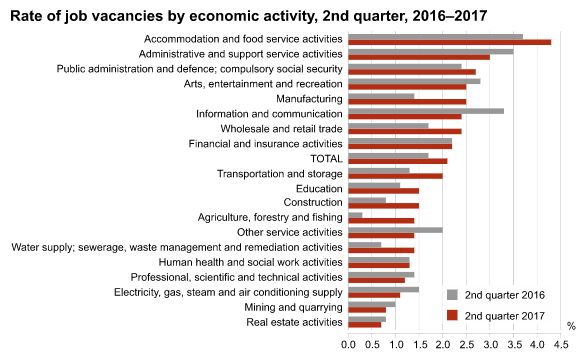Analytics, Employment, Estonia, Labour-market, Markets and Companies
International Internet Magazine. Baltic States news & analytics
Wednesday, 24.04.2024, 01:30
In Q2, the number of job vacancies was 12,000 in Estonia
 Print version
Print versionCompared to the 2nd quarter of 2016, when the number
of job vacancies reached 9,500, in the 2nd quarter of 2017, the number of job
vacancies increased by 26%.
The number of job vacancies in the 2nd quarter of 2017
was slightly higher than in the 1st quarter, when the number of job vacancies
was 11,200. Compared to the previous quarter, the number of job vacancies
increased by 7%.
The share of vacant and occupied posts in the total
number of posts continued to be the highest in manufacturing (20%), wholesale
and retail trade (15%) and education (10%). The total number of posts in the
2nd quarter was over 561,000.
The rate of job vacancies, i.e. the share of job
vacancies in the total number of posts was 2.1% in the 2nd quarter of 2017,
which is 0.1 percentage points higher than in the previous quarter, and 0.4
percentage points higher than in the 2nd quarter of 2016.

In the 2nd quarter, the rate of job vacancies was the
highest in accommodation and food service activities (4.3%) and in
administrative and support service activities (3.0%). The rate of job vacancies
was the lowest in real estate activities (0.7%) and in mining and quarrying
(0.8%).
More than three quarters (78%) of the vacant posts
were in the private sector. In the 2nd quarter of 2017, the rate of job
vacancies was the highest in state organisations (2.6%) and foreign
private-sector institutions (2.9%). The rate of job vacancies was the lowest in
local authority organisations (1.1%).
Most of the vacant posts were in Harju county (67%)
(including 51% in Tallinn), followed by Tartu county (9%) and Ida-Viru county
(6%). The number of vacant posts was the lowest in Jõgeva, Hiiu and Rapla
counties.
The movement of labour is characterised by labour
turnover (the total number of engaged employees and those who have left), which
amounted to nearly 78,700 in the 1st quarter of 2017, denoting a 3% decrease
compared to the previous quarter and an 8% increase compared to the 1st quarter
of 2016. Compared to the 1st quarter of 2016, the largest decrease in labour
turnover occurred in mining and quarrying (35%) and in information and
communication (20%), and the largest increase in real estate activities (41%),
financial and insurance activities (31%) and manufacturing (24%). In the 1st
quarter of 2017, both the number of employees hired and the number of employees
who left their job were the highest in manufacturing and wholesale and retail
trade.
The data are based on the statistical activity “Job
vacancies and labour turnover”, conducted by Statistics Estonia since 2005. In
2017, the sample includes 12,600 enterprises, institutions and organisations;
the data of randomly selected units are imputed to the total population
separately in each stratum. As of the 2nd quarter of 2016, Statistics Estonia
uses the data of the Employment Register of the Estonian Tax and Customs Board
to pre-fill the survey questionnaires. The main representative of public
interest for the statistical activity is the Ministry of Economic Affairs and
Communications, commissioned by whom Statistics Estonia collects and analyses
the data necessary for conducting the statistical activity. The number of job
vacancies is the total number of job vacancies on the 15th day of the second
month of a quarter. A job vacancy is a paid post that is newly created,
unoccupied or becomes vacant when an employee leaves, and for which the
employer is actively trying to find a suitable candidate from outside the
enterprise, institution or organisation concerned.








 «The Baltic Course» Is Sold and Stays in Business!
«The Baltic Course» Is Sold and Stays in Business!

